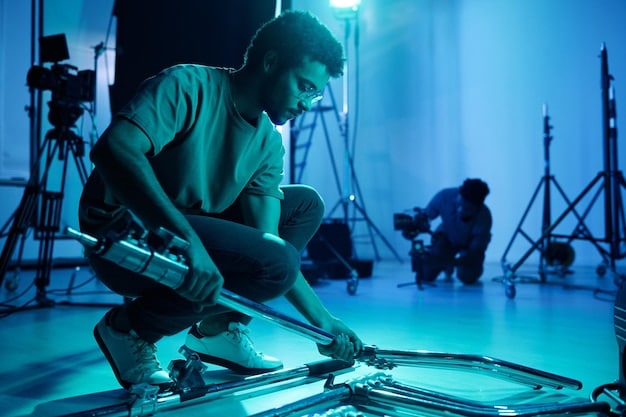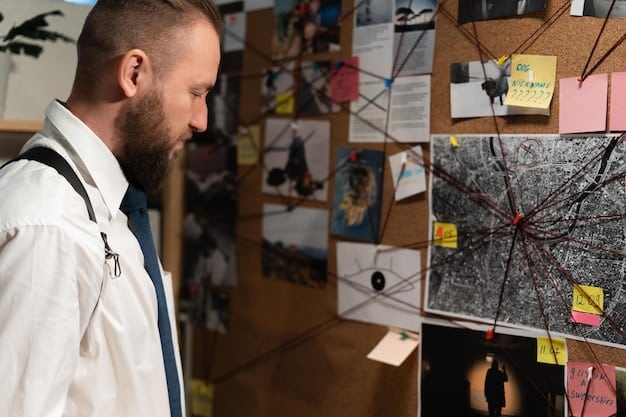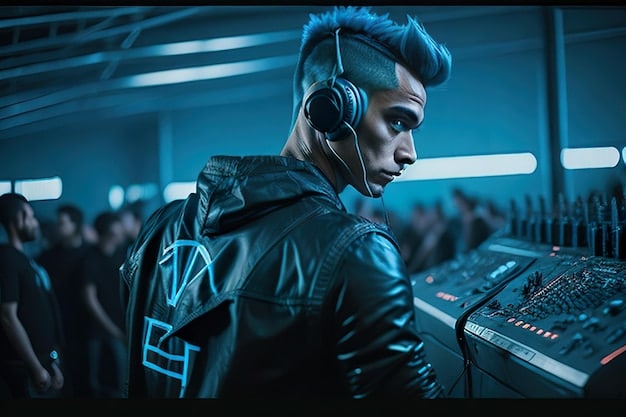5 Innovative Short Film Techniques of 2025: Director’s Guide

Exploring the cutting-edge of cinematic innovation, this guide reveals five transformative short film techniques poised to redefine visual storytelling in 2025, offering directors invaluable insight into elevating their craft and captivating audiences.
The world of filmmaking is in constant motion, an ever-evolving landscape where creativity breeds innovation. For directors navigating this dynamic environment, staying ahead of the curve isn’t just an advantage—it’s a necessity. This exploration into Unveiling the 5 Most Innovative Short Film Techniques of 2025: A Director’s Guide aims to equip filmmakers with the insights needed to push boundaries and resonate deeply with audiences. Prepare to discover methods that promise to transform concept into compelling visual artistry.
Beyond the Lens: The Rise of AI-Assisted Cinematography
The integration of Artificial Intelligence (AI) into filmmaking is no longer a distant futuristic concept; it’s rapidly becoming a practical tool that redefines what’s possible behind the camera. In 2025, AI-assisted cinematography is moving beyond mere automation, offering directors unparalleled control and creative options. This technique allows for complex shot planning, predictive motion tracking, and even dynamic lighting adjustments in real-time, streamlining production and expanding artistic horizons.
AI’s role in camera operation is particularly transformative. From drones autonomously following intricate flight paths to robotic arms executing flawlessly repeatable camera movements, AI provides precision that human operators would struggle to match. This precision is invaluable for complex sequences, enabling directors to achieve shots that were previously either too expensive, too dangerous, or simply too difficult to execute. The predictive capabilities of AI mean that cameras can anticipate actor movements, ensuring subjects remain perfectly framed and in focus, even in chaotic scenes.
Precision Framing with AI
AI algorithms can analyze scripts and storyboards to suggest optimal camera angles and movements, ensuring every frame contributes effectively to the narrative. This goes beyond simple face detection; AI can understand emotional cues and character intent to anticipate the most impactful shots.
- Automated composition: AI suggests framing based on established cinematic principles.
- Predictive tracking: Keeps subjects in focus and frame even during unscripted movements.
- Dynamic range optimization: AI adjusts exposure in real-time for perfect lighting across the frame.
Beyond the technical aspects, AI offers a new layer of creative collaboration. Directors can use AI tools to quickly prototype complex scenes, visualizing different camera movements and lighting setups without the need for expensive physical rehearsals. This iterative process allows for greater experimentation and refinement, ultimately leading to more polished and impactful final products. The ability to simulate various scenarios and predict outcomes gives filmmakers a powerful advantage, saving time and resources while maximizing creative potential. It shifts the focus from the mechanics of filmmaking to the art of storytelling, empowering directors to concentrate on performance and narrative.
Immersive Storytelling with Haptic Feedback Integration
As audiences seek deeper engagement, short films in 2025 are increasingly leveraging haptic feedback to create truly immersive experiences. This technique moves beyond traditional sight and sound, incorporating tactile sensations that allow viewers to physically “feel” elements of the story. Whether it’s the subtle vibration of a phone, a rumble in a specialized chair, or even wearable tech, haptic feedback adds an entirely new dimension to cinematic storytelling. The goal is to bridge the gap between the screen and the viewer, making them feel like an active participant rather than a passive observer.
The implementation of haptic technology isn’t about overwhelming the senses but rather about strategically augmenting key narrative moments. Imagine a scene where a character is caught in a storm; subtle vibrations can mimic the rain, or a stronger pulse can simulate a distant thunderclap. These carefully placed tactile cues can amplify emotion, tension, and connection to the on-screen action, creating a more memorable and visceral experience. Directors must meticulously design these haptic elements to complement, not overshadow, the visual and auditory components of their films.
The Craft of Tactile Narrative
Integrating haptic feedback requires a delicate balance. It’s not just about adding random vibrations; it’s about crafting a tactile narrative that enhances specific emotional beats and plot points. This means working closely with sound designers and editors to synchronize haptic cues with the film’s existing sensory elements.
- Enhancing tension: Subtle vibrations during suspenseful moments.
- Emotional resonance: Tactile cues reinforcing character feelings (e.g., heartbeat).
- Environmental immersion: Simulating rain, wind, or impacts.
The true innovation lies in the director’s ability to weave these sensations seamlessly into the storytelling. It’s about finding those precise moments where a physical sensation can elevate a scene, making it more impactful or emotionally resonant. For example, a sharp, quick vibration could accompany a jump scare, or a slow, pulsating rhythm might underscore a moment of introspection. The effectiveness of haptic feedback depends entirely on its judicious and thoughtful application, turning a passive viewing experience into one that is felt deep within the audience’s psyche. It allows for a multi-sensory dialogue between the film and its viewer, fostering a profound level of engagement.
Dynamic Narratives Through Branching Storylines
The static, linear narrative has long been the backbone of filmmaking, but 2025 is ushering in an era where audiences crave more interaction and agency. Branching storylines are emerging as a powerful technique for short films, transforming viewers from passive observers into active participants who influence the plot’s direction. This approach, borrowed from interactive media like video games, offers multiple narrative paths and endings, significantly increasing rewatchability and personalization. Directors are no longer just telling a story; they’re crafting an experience that can unfold differently each time.
Implementing branching storylines requires meticulous planning and a deep understanding of narrative arcs. It’s not simply about offering random choices, but about creating carefully considered decision points that feel organic to the story and lead to distinct, meaningful outcomes. Each choice must have a visible consequence, enhancing the viewer’s sense of control and investment in the characters’ fates. This technique challenges traditional storytelling structures, demanding a more modular and adaptable approach to scriptwriting and editing.

Crafting Multiple Realities
The complexity of managing multiple storylines necessitates innovative tools for script development and post-production. Directors now work with narrative design platforms that map out every possible choice and outcome, ensuring coherence and impact across all branches.
- Choice-driven plot progression: Viewers make decisions that alter the narrative path.
- Multiple endings: Offers diverse resolutions based on audience choices.
- Increased rewatchability: Encourages repeated viewing to explore all possibilities.
The beauty of branching narratives lies in their potential to create a tailored experience for each viewer. A short film might explore themes of morality, consequences, or identity, with each viewing session revealing new facets of the story. This technique fosters a deeper connection between the audience and the material, as viewers become personally invested in the characters’ journeys and the ramifications of their own choices. It transforms the viewing experience into a collaborative act, pushing the boundaries of what cinematic storytelling can be. The director’s challenge becomes that of an architect, building a narrative maze where every turn offers a new perspective.
Hyper-Realism with Volumetric Video and Photogrammetry
The pursuit of absolute visual fidelity has always been a driving force in filmmaking, and in 2025, volumetric video and photogrammetry are delivering unparalleled levels of hyper-realism to short films. These techniques capture subjects and environments in three dimensions, allowing for realistic movement, lighting, and spatial interaction that traditional 2D video cannot achieve. Instead of flat images, filmmakers are now working with dynamic, spatial data that can be manipulated and viewed from any angle, blurring the lines between captured reality and generated content.
Volumetric capture involves recording a performance from multiple camera angles simultaneously, creating a 3D model that can be “rendered” into a scene. Photogrammetry, on the other hand, builds 3D models of objects and environments from a series of overlapping photographs. When combined, these technologies enable directors to create incredibly lifelike digital doubles, reconstruct entire locations with astonishing accuracy, and seamlessly integrate virtual elements into real-world footage. This opens up vast possibilities for visual effects, historical reconstructions, and abstract storytelling without compromising on realism.
Building Immersive Environments
The application of these techniques extends beyond character capture, allowing directors to recreate intricate sets or even entire cities with photorealistic detail. This provides immense creative freedom, as environments can be designed or replicated with historical accuracy or fantastical invention, then populated with volumetric characters.
- 3D character capture: Captures actors’ performances in full 3D.
- Realistic environment replication: Recreates physical locations with high fidelity.
- Enhanced visual effects: Seamless integration of digital characters and objects into live-action.
For short films, these technologies offer significant advantages in production value. Directors can achieve cinematic quality that rivals large-budget features, allowing for ambitious storytelling within constrained resources. Imagine a historical drama where every detail, from the costumes to the architecture, is meticulously recreated in 3D, or a fantasy film where mythical creatures interact seamlessly with live actors in a volumetric environment. This technological leap provides a powerful tool for visual artists, enabling them to construct worlds and characters with unprecedented authenticity and creative flexibility. The result is a viewing experience that is not only visually stunning but also deeply immersive and believable.
Adaptive Soundscapes: Personalized Audio for Emotional Impact
Sound has always been half the picture, yet its potential for personalized engagement often remains untapped. In 2025, adaptive soundscapes are emerging as an innovative technique for short films, offering a dynamic auditory experience that responds to individual viewer preferences, emotional states, and even contextual factors. This goes beyond traditional surround sound, crafting an audio environment that is subtly tailored to the listener, enhancing immersion and emotional resonance without conscious intrusion.
The technology behind adaptive soundscapes relies on advanced audio processing and often incorporates AI to analyze viewer data—such as viewing history, preferred genres, or even real-time biometric feedback (with consent, of course)—to adjust the sonic elements of a film. This could mean subtly altering the musical score to match a viewer’s mood, emphasizing certain sound effects based on their prior experiences, or adjusting dialogue levels to suit their listening environment. The goal is a sound design that feels intrinsically connected to the individual, deepening their personal connection to the story.

Tailoring the Sonic Experience
Adaptive soundscapes offer directors a powerful new tool for emotional manipulation and narrative emphasis. Instead of a one-size-fits-all audio track, the film can dynamically adjust its sonic elements to maximize impact for each unique audience member, creating a truly bespoke auditory journey.
- Viewer-responsive music: Scores that adapt to individual emotional responses.
- Contextual sound effects: Audio cues that change based on the viewing environment.
- Personalized dialogue mixing: Optimizes speech clarity for different listeners.
The true artistry of adaptive soundscapes lies in their subtlety. The best implementations are often imperceptible, working beneath the conscious awareness of the viewer to enhance their engagement. Directors must collaborate closely with sound designers to map out the potential variations and ensure that the adaptive elements always serve the film’s narrative and emotional core. This technique holds the promise of making films resonate more deeply and personally, transforming the passive act of listening into an active, individualized encounter. It unlocks a new frontier in sound design, allowing for an incredibly nuanced and impactful use of auditory storytelling.
The Ethics of Innovation: Balancing Progress with Responsibility
As we embrace these groundbreaking techniques, it’s imperative to reflect on the ethical implications that accompany such rapid technological advancement. The power to create hyper-realistic visuals, responsive narratives, and deeply immersive experiences also brings the responsibility to use these tools wisely and ethically. For short film directors in 2025, navigating this landscape means considering not just what is technically possible, but what is morally permissible and beneficial for both creators and audiences. This involves a critical examination of data privacy, algorithmic bias, and the potential for manipulative storytelling.
One significant ethical consideration revolves around data collection, particularly with techniques like adaptive soundscapes or branching storylines that might track viewer preferences or biometric data. Directors and producers must ensure transparency and secure consent when utilizing such methods, prioritizing viewer privacy above all else. The potential for algorithmic bias in AI-assisted cinematography also requires careful vigilance; biases embedded in data sets can inadvertently perpetuate stereotypes or limit creative representations. Filmmakers have a role in actively challenging these biases and ensuring equitable and diverse representation in their work.
Navigating the Ethical Minefield
The ethical landscape of innovative filmmaking is complex and multifaceted, demanding thoughtful consideration from every director. It’s about building a framework that ensures technological progress serves human creativity and well-being, rather than compromising it.
- Data privacy: Ensuring transparency and consent in data collection for personalized experiences.
- Algorithmic bias: Actively mitigating biases in AI tools to promote diverse representation.
- Responsible storytelling: Avoiding manipulative tactics in immersive narratives.
Ultimately, innovation should empower storytelling, not exploit the audience. Directors must engage in critical dialogue about the broader societal impact of their work, balancing artistic ambition with ethical responsibility. This means embracing new tools with caution, educating themselves on their potential pitfalls, and advocating for industry standards that protect both creators and consumers. The future of short film lies not just in cutting-edge techniques, but in the conscientious application of those techniques to tell stories that are both compelling and ethically sound. It’s a call for informed creativity, ensuring that as technology advances, humanity remains at the heart of our cinematic endeavors.
| Key Innovation | Brief Description |
|---|---|
| 🤖 AI-Assisted Cinematography | Utilizes AI for precise shot planning, predictive tracking, and dynamic lighting. |
| ✋ Haptic Feedback Integration | Incorporates tactile sensations to enhance immersive storytelling and emotional impact. |
| 🌳 Branching Storylines | Allows viewers to make choices that alter the narrative path and lead to different endings. |
| ✨ Volumetric Video & Photogrammetry | Captures subjects and environments in 3D for hyper-realistic visuals and spatial interaction. |
Frequently Asked Questions About Short Film Innovations
AI-assisted cinematography uses artificial intelligence to aid in camera operations, shot planning, and real-time adjustments. It benefits short films by offering enhanced precision for complex shots, automating tedious tasks, and allowing directors to achieve highly sophisticated visual effects and camera movements with greater efficiency and lower costs.
Haptic feedback integrates tactile sensations into the film experience, allowing viewers to “feel” elements of the story, such as vibrations or pulses. This physical engagement deepens emotional resonance, increases immersion, and creates a more memorable and visceral connection to the narrative, particularly during tense or impactful scenes.
Branching storylines present a challenge in narrative complexity, requiring extensive planning and modular scriptwriting. However, their advantages include creating an interactive, personalized viewing experience, increasing audience engagement through choice, and significantly boosting rewatchability as viewers explore different plot outcomes and endings.
Volumetric video captures live performances simultaneously from multiple angles to create a 3D model, allowing for dynamic, spatial manipulation. Photogrammetry constructs 3D models of objects and environments from a series of photographs. Both aim for hyper-realism, with volumetric suitable for characters and photogrammetry for static objects and intricate sets.
Adaptive soundscapes dynamically adjust a film’s audio elements—music, effects, dialogue—based on viewer data or context. They are innovative because they personalize the auditory experience, subtly enhancing emotional impact, immersion, and individual connection to the story. This creates a uniquely tailored aural journey for each audience member.
Conclusion: The Future is Now for Short Film Directors
The landscape of short film is undergoing a profound transformation, driven by an explosion of innovative techniques that promise to redefine storytelling. From the precision of AI-assisted cinematography and the immersive touch of haptic feedback, to the interactive depth of branching storylines, the hyper-realism of volumetric video, and the personalized engagement of adaptive soundscapes, directors in 2025 have an unprecedented toolkit at their disposal. These advancements are not merely technological novelties; they are powerful narrative instruments that empower filmmakers to craft experiences that are more engaging, more personal, and ultimately, more resonant with audiences. As we embrace these cutting-edge methods, it is crucial to remember the ethical responsibilities that accompany such power. The true innovation lies not just in the technology itself, but in the thoughtful and responsible application of these techniques to tell compelling, meaningful stories that push the boundaries of what short films can achieve, ensuring that humanity and creativity remain at the heart of cinematic art.





